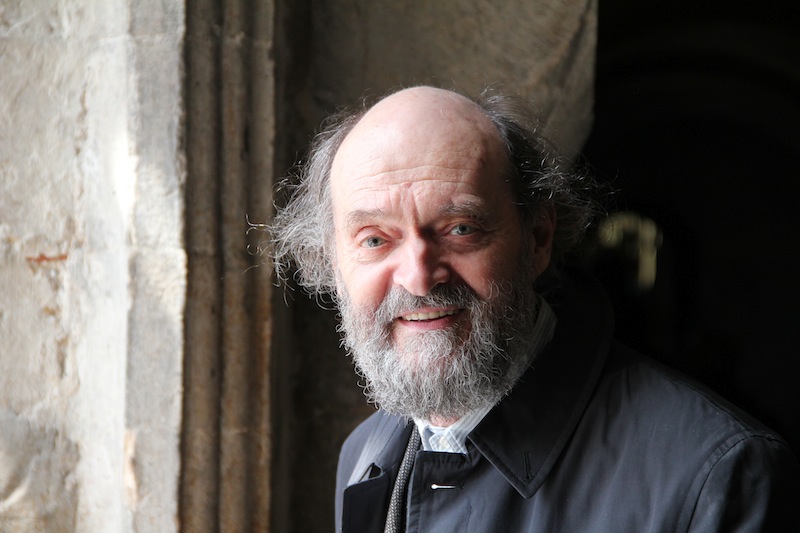Pärt’s music fills and transcends the Temple of Dendur
Arvo Pärt’s music reaches far past the audience for classical music, speaking to every kind of listener. His music is beautiful, but not simplistic, nor does it pander, like that of other “crossover” composers—Pärt’s art is rigorous, luminous, but also ascetic. He combines a sophisticated sense of harmony and form with the most minimal materials, and his command of the relationship between dissonance and consonance is the finest of living composers.
He is a recording star as well, and CDs are how most of his fans experience his work. Pärt is one of the unique musicians where this is often the ideal way to hear him. Noisy, inattentive concert audiences and flawed performances do substantial damage to his music, which demands concentration and pristine playing.
A concert then, like Friday night’s “Arvo Pärt at 80,” held in the Temple of Dendur at the Metropolitan Museum of Art, should ideally be conceived and presented as something different than the standard applause-music-applause spin-cycle.
And so it was. Although not as flawlessly crafted as his pieces, nor as finely engineered as his recordings, the sequence of fourteen different works (including two versions of Frartres) produced an immersive, comforting, clarifying experience.
Set in the giant, high space, with a reflecting pool, a huge glass wall facing Central Park, and statues of Amenhotep III and the Sphinx placidly watching over the audience, the concert was a non-denominational social ritual. As in a house of worship, people gathered together while in private thought.
That is the Pärt listening experience. He’s a social composer, and his music, as pure as it may sound, is not abstract. It is always about something—whether that is an explicit but non-proselytizing Christianity or a more general human connection, mediated by the sense that music is the expression of the soul, his music always makes an intimate connection.
The museum amplified the instruments (played by members of the New Juilliard Ensemble) and singers—baritone Christopher Herbert and mezzo-soprano Jacqueline Horner-Kwiatek. This was probably unavoidable in such a large, reverberant space, and though the sound design was impressively seamless and transparent, the amplification meant that the music was not as quiet as it really should be. The sound was also unforgiving to the string players, who had frequent, obtrusive lapses of intonation in the opening string quartet version of Frartres and later, the small-scale set of Da Pacem Domine, Psalom, and Summa.
All of the works on the program were shorter pieces or miniatures. Frartres and Spiegel im Spiegel, played by cellist Khari Joyner and pianist Robert Fleitz, were the most substantial. They played Spiegel im Spiegel with gentle precision and excellent control. A segued sequence of Für Alina, Für Anna Maria, and Pari intervallo for piano four-hands was equally inspirational, Fleitz and second pianist Mika Sasaki holding a quiet focus and playing Pärt’s deceptively simple phrases with elegance.
The vocal music stood out. Herbert sang the Pilgrim’s Song, with string quartet, and Horner-Kwiatek sang Es sang vor langen Jahren and My Heart’s in the Highlands. Both singers projected easily into the hall, and their clear, direct and shining voices were perfect for the music’s aesthetics.
The program kept the flow of music as constant as feasible, with segues and relatively rapid change-overs. With less downtime, the playing joined with the environment in unexpected and marvelous ways: ripples reshaped the reflections from the walls and ceilings in the pool into an unexpectedly beautiful music video; the slowly setting sun accompanied Pari intervallo; and as darkness fell, a group of cicadas that had somehow made a home in the upper recesses of the museum answered the music with their rasping mating song, seemingly puzzled that what they got back was harmonies and melodies.
The large audience went along for the most part, listening quietly and avidly, holding applause for those few precious moments of quiet once that last note finished reverberating. But gradually fatigue set in, and small groups of concert-goers began to leak out—strangely—after a little more than an hour into what was scheduled to be ninety minutes of music. And as the concert went deeper, and the playing grew stronger, the audience seemed less patient for any time spent contemplating what they had just heard.
Their impatience was the only thing that marred the final piece, a performance of choreographer Christopher Wheeldon’s Liturgy, set to the violin and piano version (Sasaki and violinist Alex Shiozaki) of Fratres. Liturgy was achingly affecting. Principal dancers with the New York City Ballet, Amar Ramasar and Rebecca Krohn’s gestures were exquisitely graceful, and the choreography acutely echoed the music’s rhythms and phrases with a magical, quicksilver beauty.



